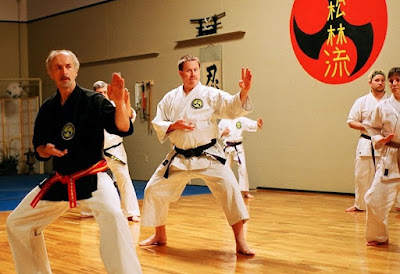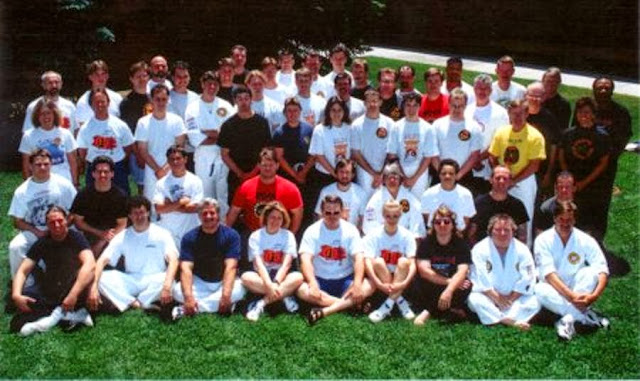
| Our Soke, grandmaster of Shorin-Ryu Karate & Kobudo, demonstrating the Okinawa art of kobudo. |
Traditional Karate is considered to be a combat art and referred to as karatedo. The 'do' attached to karate referring to a life-long path one must take for enlightenment and better health. It may also be referred to as karate-jutsu - implying that kata (forms) are not a major part of the system. Over the years, many faculty and university students have trained in Shorin-Ryu Karate and Kobudo and many have moved on to teach martial arts, science, engineering, etc at universities around the world. Their interest in the traditional martial arts is related to structured karate classes and training that provide opportunities to learn traditions, karate history, philosophy, techniques and some Japanese language.
Over the past few decades, one instructor purposely focused on teaching martial arts to adults. Grandmaster (soke) Hausel taught karate, kobudo, samurai arts, self-defense and many other arts at Arizona State University, the University of New Mexico, University of Utah, and for 3 decades at the University of Wyoming as well as at Golds Gym and other facilities; thus, his experience is teaching adults. Because of his unique position in teaching at four universities, he was presented some unique credentials including kyoju (Professor of Budo). Budo translates as 'martial arts'. And as a geologist, he was presented many awards.
While teaching at the University of Wyoming, he trained a few thousand college students along with many faculty and university staff. When he moved to Gilbert, Arizona in 2006, he had hoped to establish a similar curriculum at ASU, CGCC or MCC, but found the university bureaucracy and community college bureaucracy too difficult to work with, so he opened the Arizona Hombu Dojo in Mesa.
 |
| Soke demonstrates the Japanese art of iaido. |
Over the past few decades, one instructor purposely focused on teaching martial arts to adults. Grandmaster (soke) Hausel taught karate, kobudo, samurai arts, self-defense and many other arts at Arizona State University, the University of New Mexico, University of Utah, and for 3 decades at the University of Wyoming as well as at Golds Gym and other facilities; thus, his experience is teaching adults. Because of his unique position in teaching at four universities, he was presented some unique credentials including kyoju (Professor of Budo). Budo translates as 'martial arts'. And as a geologist, he was presented many awards.
While teaching at the University of Wyoming, he trained a few thousand college students along with many faculty and university staff. When he moved to Gilbert, Arizona in 2006, he had hoped to establish a similar curriculum at ASU, CGCC or MCC, but found the university bureaucracy and community college bureaucracy too difficult to work with, so he opened the Arizona Hombu Dojo in Mesa.
Okinawan karate and kobudo are taught at the Hombu in Gilbert Arizona includes classes and special training such as traditional karate classes, jujutsu, self-defense, body hardening, samurai arts and martial arts weapons known as kobudo. These are all taught weekly at tour school located in the Phoenix East Valley. We unfortunately had to close our commercial dojo in Mesa on March 1, 2021 because of the plandemic, but we are now training at four different locations in Gilbert and Mesa (contact sokeshodai@yahoo.com)
On Okinawa, karate and kobudo evolved from Shaolin Kung Fu and became the premier form of self-defense in the world. The art was kept secret from all outsiders until the beginning of the 20th century. This martial art is considered pragmatic self-defense and not taught as sport. Over the years, a few thousand university students, staff and faculty have trained in the Shorin-Ryu martial arts.
 |
| University of Wyoming karate and kobudo class |
 |
| The Okinawa art of karate |
| Tea house at the Phoenix Japanese Peace Garden |




.jpg&container=blogger&gadget=a&rewriteMime=image%2F*)
